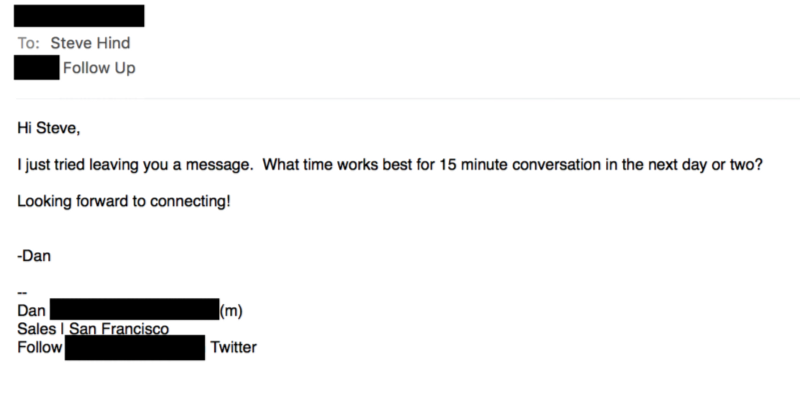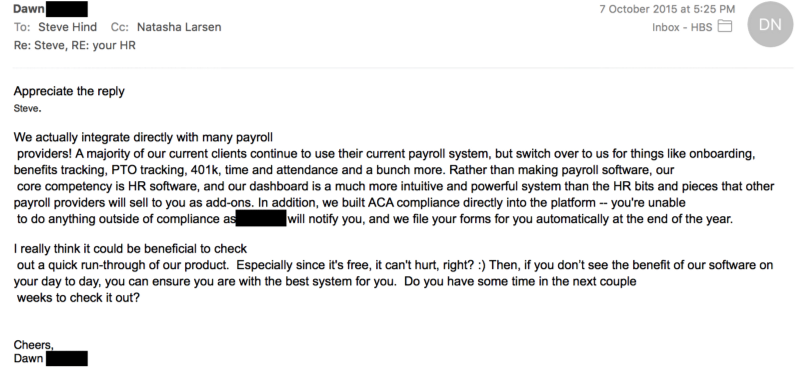
By Steve Hind, Harvard Business School Class of 2016
Your inside sales team’s faux-personal, harassing emails make me hate your company.
Inside sales, we hear, is the future of sales, at least in B2B. But as a person who is on the receiving end of inside sales tactics roughly once a month, at least one of two things is true: it doesn’t really work on reasonably informed buyers, or its being practiced so badly so widely that the whole channel is at risk of collapsing.
I tend to think both of those things are true, and I’ll explain why. But first:
Inside sales
‘Inside’ sales refers to selling by staff who don’t leave the office, and who rely primarily on email and phone calls to qualify leads and make sales. This isn’t sales support — using a call centre to prospect leads for field sales to follow up — it’s a separate channel. Its proponents argue that its lower cost structure supports a better sales channel for cheaper products, or a higher margin sales channel for more expensive ones.

The cost advantage comes from eliminating travel costs and time, and increasing the call rate of sales reps. Call rates can be increased with incentives or targets (sit people at a desk and make them “dial for dollars”). Or call rates can be increased with technology, that lets reps automate communications that look to the recipient like they were personalized. More on that in a second.
I took a class last fall that featured a guest lecture about inside sales fromMark Roberge, the CRO of Hubspot. Mark built and scaled an incredibly successful inside sales team at Hubspot. And in the lecture we looked in a lot of depth at Qualtrics, who it seems did the same thing. I have no reason to doubt that both companies (and no doubt many more) have done lots of highly effective inside sales. In particular, it is undoubtedly a good thing to use inside sales where it allows you to reach out to customers that it would be uneconomic to sell to via field sales channels, but for whom lower-touch channels won’t work.
But as someone who has done inside sales work (before I knew what it was) and who has been the receiving end of a fair bit of it in 2015, I think something is amiss. I think it’s less effective than it seems and that as it becomes more common, it is both being practiced less well and is becoming less effective.
Does inside sales work?
This is the third email I’ve received from ‘Dan’ in the last two weeks (I’ve removed full names, emails and company info for the sake of not being mean):

In the fall, I used Dan’s company’s product for 45 minutes in a class. I have not used it since, and don’t intend to. I’m not even a good customer: Dan’s previous emails were trying to introduce me to their enterprise offerings. Despite that, and despite my not having replied to Dan the last two times, I’m still getting emails.
Why is Dan emailing me? It turns out that one of the secrets of inside sales is persistence: the data I’ve seen suggests that you need to contact people five to six times to get a response.
That’s where the tech comes in. If Dan had to write five to six emails sunny emails to everyone before he got a response from some of them, he would run out of hours in the day, or quit, or both. But instead, Dan can automate this process (at least in part) so that it’s not really any trouble for him to send a couple hundred emails a day. And he can set up an email schedule so that if I don’t reply to his first email, he’ll automatically send me another after a pre-programmed interval. If someone does reply, he will be able to scan and response and choose from one of several pre-written responses to send. Voila — Dan is managing a massive portfolio of leads with minimal time and effort.
These inside sales tactics work because the emails do seem personalized. How can I just leave Dan hanging?
I wasn’t always so cold. Last year, when I was running a small student media organization, I was pitched on a service by that company’s Director of HR. This wasn’t sales drone Dan — this was a serious mover at a fast-growing unicorn.

I think I had just done the class on inside sales, so in the spirit of pipeline optimization, I replied and explained that we weren’t interested, and besides were really small and not a great client for them:

But the logic of inside sales, remember, is technologically-assisted persistence. While a human who was Director of HR for a company would probably have better things to do than write me back again, a human who would reply with a couple clicks may as well do it:

Note two things here: a. not fixing formatting when you copy paste in a name kind of reveals what’s behind the curtain and b. inside sales is about persistence. (The email is kind of pushy, right? “I really think it could be beneficial… Especially since it’s free, it can’t hurt, right? :)”)
Here’s the problem: inside sales relies on it appearing to be a higher touch channel than it is. I’m more likely to respond if I think it really is a real executive, or even just a real person, emailing me. But doing that at scale requires either high costs, or automation. At that point, it’s hard to keep up the pretense.
No doubt this works for people who haven’t seen it much. It worked for me when I was using these tactics on small businesses in a previous job. But once you’ve experienced it a couple of times, and started to see the curtain slip, it becomes really easy to just ignore the emails. And worse, once you know that you’re getting pushy tactics from an auto-mailer, it makes you kind of hate the company.
I’m not saying the few sales attempts I’ve received are best in class. They’re probably not. But they are shaping how I view all attempts to sell to me through this channel.
Will inside sales keep working or go the way of the stranded prince scam?
This is the problem as I see it: inside sales tactics become less and less effective the more companies use them. And that happens even faster when some companies use irritating or sloppy tactics.
It’s likely that the first stranded prince scam or penis enlargement spam emails work pretty effective at first. But as that ‘channel’ got saturated with poorer and poorer imitators of the originals, I bet the success rates for everyone fell. And that would be true if those emails still work sometimes, which they probably do.
This channel saturation isn’t a new thing in marketing. It happens in paid and free channels. Take search. Paid search ads get more expensive as more companies use them, while consumers notice and react to them less. On the free side, SEO was the way to get in front of customers, until everyone started doing SEO on the best key words, and it became harder and less effective.
None of this, I think, argues that inside sales is a bad channel. I’m sure that done well and for the right products it’s good. But it does suggest that some of its success might have been due to its newness. And it suggests that we have reason to believe it will become a less effective channel over time. That points it the way of the next fad, not the next big thing.




